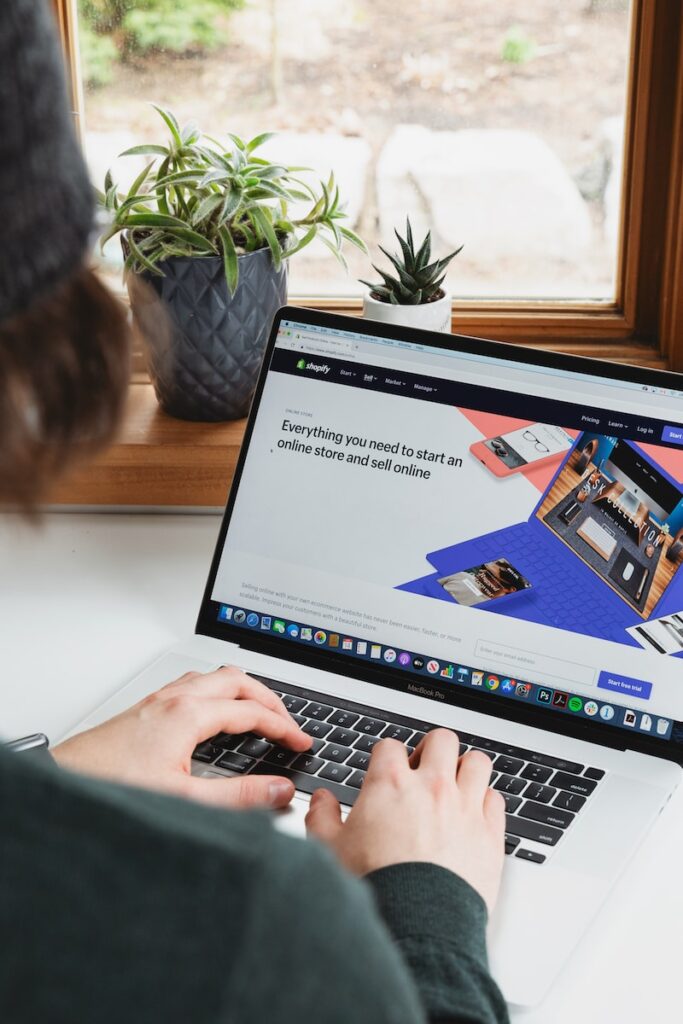Are you ready to turn your passion for blogging into a profitable online venture? If so, get ready to uncover the secrets of blog monetization and unlock your potential to make money online. In this comprehensive guide, we will explore ten proven strategies to monetize your blog and start earning a steady income from your online endeavors.
Blog monetization refers to the process of leveraging your blog’s content, audience, and influence to generate revenue. It’s an exciting journey that allows you to transform your love for writing and sharing knowledge into a sustainable source of income. Imagine getting paid to do what you enjoy, while building a thriving online business and connecting with a global audience.
In this day and age, the possibilities for monetizing your blog are endless. From advertising and sponsored content to online courses and affiliate marketing, there are multiple avenues you can explore to turn your blog into a lucrative venture. The digital landscape presents countless opportunities for bloggers to earn money while pursuing their passions.
Throughout this guide, we will delve into each monetization strategy in detail, providing you with practical tips, insights, and real-life examples. But before we dive into the specifics of blog monetization, let’s take a moment to understand the immense potential it holds and why it’s worth your time and effort.
When done strategically, blog monetization can offer you financial freedom, flexibility, and the ability to shape your own destiny. It’s not just about making money; it’s about creating a sustainable online business that aligns with your interests and values. The beauty of blog monetization is that it allows you to build a platform where you can share your expertise, engage with your audience, and make a positive impact on others.
Whether you’re an experienced blogger looking to take your monetization efforts to the next level or a beginner considering starting a blog with the intent of generating income, this guide is your roadmap to success. We’ll explore ten powerful strategies that will unlock the doors to blog monetization and help you embark on a rewarding online journey.
So, are you ready to dive in? Let’s begin by understanding the fundamental principles of blog monetization and when the right time is to start monetizing your blog. Get ready to unleash your blog’s potential and start earning money online. Exciting opportunities await!
Blog Monetization Starts With Strategy

Before diving into the various methods of blog monetization, it’s crucial to understand why having a well-defined strategy is the key to successful blog monetization. A solid strategy sets the foundation for maximizing your revenue potential and ensuring that your monetization efforts align with your blog’s goals. By approaching monetization with a strategic mindset, you can effectively navigate the vast landscape of opportunities and make informed decisions that yield long-term success.
One of the primary reasons why a strategy is essential is that it allows you to identify the most effective monetization methods for your specific blog and target audience. Every blog is unique, and what works for one may not work for another. With a strategy in place, you can assess your blog’s niche, audience demographics, and content to determine the most suitable monetization avenues. This approach enables you to focus your resources and efforts on strategies that are most likely to generate significant returns.
Additionally, a well-thought-out strategy helps you optimize your monetization efforts for maximum revenue. By considering factors such as pricing models, advertising placements, and content offerings, you can strategically position your blog to attract advertisers, sponsors, and customers. Without a strategy, you may find yourself engaging in ad hoc monetization attempts that don’t yield the desired results or maximize your earning potential.
Moreover, a strategic approach to blog monetization ensures that your monetization efforts align with your blog’s overarching goals and purpose. When you have a clear vision for your blog’s direction, you can select monetization strategies that not only generate income but also enhance the overall user experience and provide value to your audience. This alignment is crucial for maintaining the authenticity and integrity of your blog while capitalizing on monetization opportunities.
Crafting a blog monetization strategy involves thoughtful planning, research, and analysis. Start by evaluating your blog’s current state, identifying your target audience, and understanding their needs and preferences. This knowledge will serve as the foundation for selecting the most appropriate monetization methods. Consider factors such as your blog’s niche, content format, and engagement levels to determine the strategies that best complement your blog’s unique characteristics.
Before delving into the various monetization methods available, it’s crucial to establish a solid strategy for your blog. A well-defined strategy empowers you to make informed decisions, optimize your revenue potential, and ensure that your monetization efforts align with your blog’s goals. By taking a strategic approach, you position yourself for long-term success in the ever-evolving world of blog monetization. So, invest the time and effort into developing your strategy—it will be the driving force behind your blog’s profitability and sustainability.
When Should You Start to Monetize Your Blog?

Timing is crucial when it comes to monetizing your blog. While the prospect of earning money from your blog can be enticing, it’s important to consider certain factors before implementing monetization strategies. Let’s explore the indicators that suggest you’re ready to start making money from your blog.
One common concern among bloggers is whether monetization will compromise the quality or authenticity of their content. It’s essential to build a solid foundation for your blog before monetizing it. This includes creating valuable, engaging, and informative content that resonates with your target audience. By establishing a loyal readership and delivering consistent value, you build trust and credibility, making your blog an attractive platform for potential advertisers, sponsors, and customers.
Another factor to consider is the size and engagement of your audience. While there isn’t a specific threshold that indicates the ideal time to monetize, having a decent following can increase your chances of success. Focus on growing your audience organically, nurturing relationships with your readers, and fostering an engaged community. When you have an active and loyal audience, you have a higher chance of generating income through various monetization methods, such as sponsored posts, affiliate marketing, or selling your own products.
Additionally, it’s crucial to assess your blog’s niche and its compatibility with monetization strategies. Some niches naturally lend themselves to monetization, while others may require more creativity and strategic planning. Evaluate the market demand for your niche, the availability of potential advertisers or affiliate programs, and the willingness of your audience to pay for premium content or products. Understanding the monetization landscape within your niche will help you make informed decisions and select the most suitable strategies.
Lastly, consider your long-term goals for your blog. Monetization should align with your overall vision and objectives. If your primary goal is to create a sustainable online business and generate income, then monetizing earlier in your blogging journey may be a priority. On the other hand, if your focus is on building a strong brand and establishing yourself as an authority in your niche, you may choose to delay monetization until you’ve achieved a certain level of recognition and credibility.
The decision to monetize your blog should be based on careful consideration of multiple factors. Building a loyal readership, creating valuable content, and understanding your niche and long-term goals are essential indicators that suggest you’re ready to start monetizing. Remember that monetization shouldn’t compromise the integrity of your blog or the experience of your audience. When done strategically and authentically, blog monetization can be a rewarding way to turn your passion into a profitable venture.
5 Immutable Laws of Blogging

Building a successful blog requires adhering to these five immutable laws. Let’s delve deeper into each principle and understand how they contribute to monetization.
Focus
The first law of blogging is to establish a clear focus for your blog. Narrowing down your niche allows you to target a specific audience and become a go-to resource in that area. By honing in on a particular topic, you can attract a dedicated audience that shares a common interest. This focused approach helps you stand out in a crowded blogosphere and increases your chances of monetization. Advertisers and sponsors are more likely to partner with blogs that have a specific niche and a highly engaged audience.
Quality
Consistently delivering high-quality content is the second law of blogging. Your readers expect valuable, informative, and well-crafted posts that meet their needs and interests. Quality content not only keeps your audience engaged but also helps build trust and credibility. When visitors perceive your blog as a reliable source of information, they are more likely to return, share your content, and engage with your monetization efforts. Whether you’re writing articles, creating videos, or producing podcasts, prioritize quality in every piece of content you publish.
Value
Providing value to your audience is crucial for successful blog monetization. Value can come in different forms, such as practical tips, expert insights, in-depth tutorials, or entertaining stories. Understand your readers’ pain points, desires, and interests, and tailor your content to address those needs. By consistently delivering value, you establish yourself as a trusted authority in your niche, which opens up opportunities for partnerships, collaborations, and monetization avenues. Focus on solving problems, fulfilling desires, and enhancing the lives of your audience through your blog.
Engagement
Building a strong connection with your readers is the fourth law of blogging. Encourage engagement by actively seeking and responding to comments, fostering discussions, and creating a sense of community. Engaging with your audience not only strengthens the bond between you and your readers but also provides valuable insights and feedback. Social media platforms are another avenue to interact with your audience and promote your blog. The more engaged your audience is, the more likely they are to support your monetization efforts, whether through affiliate links, sponsored content, or product purchases.
Authority
Establishing yourself as an authority in your niche is the fifth law of successful blogging. Authority is earned through expertise, knowledge, and consistent delivery of valuable content. By positioning yourself as an expert, you build credibility and trust with your audience. This credibility opens doors to collaboration opportunities, guest posting, speaking engagements, and product creation. Monetization becomes easier when brands and readers perceive you as a respected and authoritative voice in your niche.
These five immutable laws of blogging—Focus, Quality, Value, Engagement, and Authority—form the foundation of a successful and monetizable blog. By narrowing down your niche, delivering high-quality content, providing value to your audience, fostering engagement, and establishing yourself as an authority, you create a platform that attracts loyal readers and opens up various monetization opportunities. Remember, monetization should always be aligned with providing value to your audience, ensuring a win-win scenario for both you and your readers.
Read: The 5 Immutable Laws of Persuasive Blogging.
1. Become a Freelance Blogger in Your Niche

Utilizing your blogging skills to become a freelance blogger is a lucrative path to monetization. Here’s how you can get started.
As a successful blogger, you have already honed your writing skills and built a solid online presence. Now, it’s time to leverage your blog as a portfolio and offer your freelance writing services. By capitalizing on your expertise in your niche, you can attract clients and generate additional income. Here are some essential steps to kickstart your freelance blogging career.
- Showcase Your Expertise: Your blog serves as a testament to your writing skills and knowledge in your niche. Ensure that your blog posts demonstrate your expertise and showcase your unique perspective. Potential clients will be more likely to hire you if they see your blog as a valuable resource in your field.
- Build a Professional Portfolio: Compile a portfolio of your best blog posts and any guest posts or published articles you have written. This portfolio will give potential clients a comprehensive view of your writing style and capabilities. Consider creating a separate page on your blog or using platforms like LinkedIn or Contently to showcase your portfolio.
- Network and Seek Opportunities: Actively engage in your niche community by participating in discussions, leaving comments on other blogs, and connecting with industry professionals on social media. Networking can help you discover freelance opportunities, gain exposure, and establish valuable connections.
- Find Freelance Writing Platforms: Join reputable freelance writing platforms, such as Upwork, Freelancer, or Fiverr, to find clients seeking writers in your niche. These platforms provide a platform for freelancers to showcase their skills and connect with potential clients.
- Set Competitive Rates: Determine your pricing structure based on factors such as your experience, the complexity of the writing task, and market rates. Research what other freelance bloggers in your niche charge to ensure your rates are competitive. Initially, you may need to offer discounted rates or take on lower-paying gigs to build your reputation and client base.
- Deliver Exceptional Work: When working with clients, strive to deliver high-quality content that exceeds their expectations. Pay attention to their requirements, communicate effectively, and meet deadlines. Providing exceptional work not only satisfies clients but also helps you build a positive professional reputation and generate referrals.
- Seek Testimonials and Reviews: Request feedback and testimonials from satisfied clients. Positive testimonials add credibility to your freelance blogging services and can be showcased on your website or freelance profiles. Social proof plays a significant role in attracting new clients.
Remember, building a successful freelance blogging career takes time and effort. Continuously improve your writing skills, stay updated with industry trends, and actively market your services. As you gain experience and establish a professional reputation, you can expand your client base and increase your rates.
By leveraging your blog as a portfolio and offering freelance writing services, you can monetize your blogging skills while exploring new opportunities and expanding your online presence. Embrace the freelance blogging journey and watch your income grow as you turn your passion into a profitable venture.
2. Provide subscription-based content

Offering subscription-based content allows you to provide exclusive value to your dedicated audience. Discover how you can implement this monetization strategy effectively.
In the world of blog monetization, providing subscription-based content has become a popular and effective way to generate revenue while offering unique benefits to your loyal readers. By gating certain content or creating premium memberships, you can provide exclusive access to valuable resources, in-depth tutorials, insider information, or personalized support. Let’s explore how you can implement this strategy successfully.
- Understand Your Audience’s Needs: Before implementing a subscription model, it’s crucial to understand your audience’s interests and pain points. Conduct surveys, analyze feedback, and engage with your readers to identify the type of content they are willing to pay for. This ensures that your subscription offerings align with their expectations.
- Choose the Right Subscription Model: There are various subscription models you can consider, depending on the nature of your blog and audience preferences. One popular approach is tiered pricing, where you offer different subscription levels with increasing benefits and access. You can also opt for a membership-based model, granting subscribers exclusive privileges, such as early access to new content, member-only forums, or personalized consultations.
- Deliver High-Value Content: To entice readers to subscribe, it’s crucial to deliver exceptional value through your subscription-based content. Create content that goes above and beyond what is available for free on your blog. This could include in-depth tutorials, case studies, expert interviews, downloadable resources, or exclusive discounts. The key is to make subscribers feel they are receiving premium content that justifies their investment.
- Establish Clear Pricing: Determine the appropriate pricing for your subscription offerings by considering factors such as the value of your content, market trends, and the expectations of your audience. Research what similar bloggers or industry influencers charge for similar subscription models. Test different pricing strategies and gather feedback from your audience to find the sweet spot that balances affordability for subscribers and profitability for you.
- Market Your Subscription Offerings: Once you’ve established your subscription-based content, it’s crucial to market it effectively. Leverage your existing blog audience and social media presence to create awareness about the exclusive benefits of subscribing. Use compelling copywriting, persuasive calls-to-action, and visual elements to highlight the value subscribers will receive. Additionally, consider offering a free trial or limited-time promotions to attract new subscribers.
- Provide Exceptional Subscriber Experience: To retain subscribers and build a strong reputation, prioritize delivering an exceptional subscriber experience. Respond promptly to their inquiries, provide personalized support, and regularly update your subscription content. Actively engage with your subscribers by hosting exclusive webinars, live Q&A sessions, or community events to foster a sense of belonging and exclusivity.
By providing subscription-based content, you can not only monetize your blog effectively but also deepen the connection with your dedicated audience. Remember, the key to success lies in understanding your audience’s needs, delivering high-value content, and creating a seamless subscriber experience. Embrace the potential of subscription-based monetization and unlock new possibilities for your blogging venture.
3. Launch an affiliate marketing program

Affiliate marketing is a popular monetization method among bloggers. Let’s uncover the secrets to success in launching your own affiliate marketing program.
Affiliate marketing presents a fantastic opportunity to generate passive income through your blog. By partnering with relevant companies and promoting their products or services, you can earn a commission for every successful referral or sale. Here’s how you can launch an effective affiliate marketing program.
- Choose Relevant Products: Selecting the right affiliate products is crucial to the success of your program. Focus on products or services that align with your blog’s niche and cater to your audience’s interests. Consider the quality, reputation, and relevance of the products before joining any affiliate programs. Remember, promoting products you genuinely believe in will build trust with your readers.
- Integrate Affiliate Links Strategically: Integrate affiliate links seamlessly into your content to make them more enticing and clickable. Avoid overly promotional or spammy tactics that can deter your readers. Instead, weave the affiliate links naturally within your blog posts, product reviews, or resource recommendations. Use compelling anchor texts or call-to-action buttons that encourage your audience to click and explore the affiliate products.
- Disclose Affiliate Relationships: Transparency is key in affiliate marketing. Always disclose your affiliate relationships to maintain trust and comply with legal requirements. Clearly state that you may earn a commission from the purchases made through your affiliate links. Disclosing your affiliate status helps your audience make informed decisions and reinforces your credibility as a blogger.
- Track Conversions and Performance: Implement robust tracking systems to monitor the performance of your affiliate links and measure your conversions accurately. Most affiliate programs provide tracking tools and dashboards to help you analyze clicks, impressions, and sales. Pay attention to metrics like click-through rates, conversion rates, and earnings per click to optimize your affiliate marketing strategy and identify top-performing products.
- Provide Value and Authenticity: Your audience relies on your expertise and trust in your recommendations. Always prioritize providing value and authenticity in your affiliate promotions. Thoroughly review and use the products you promote, and share your honest opinions and experiences. Craft persuasive content that highlights the benefits and solves problems for your readers. By demonstrating your genuine passion and knowledge, you’ll encourage more conversions.
- Promote Ethically and Responsibly: While affiliate marketing can be lucrative, it’s important to promote products responsibly. Avoid misleading or false claims about the products you endorse. Be transparent about any limitations or drawbacks. Prioritize the long-term relationship with your audience over short-term gains. Your reputation as a trustworthy blogger is invaluable and will contribute to the sustainability of your affiliate marketing program.
Launching an affiliate marketing program can be a game-changer for your blog’s monetization efforts. By selecting relevant products, integrating affiliate links strategically, and providing authentic recommendations, you can create a win-win situation for yourself, your audience, and the companies you partner with. Embrace the potential of affiliate marketing and start earning passive income through your blog today.
4. Create and sell an online course

Online courses offer an excellent opportunity to monetize your expertise. Discover how you can create and sell an online course that resonates with your audience.
In today’s digital age, the demand for online learning has skyrocketed. People are eager to acquire new skills, expand their knowledge, and learn at their own pace. As a blogger, you can tap into this growing market by creating and selling your own online course. Here’s how you can get started:
- Identify Your Expertise: Determine the subject or topic in which you have valuable knowledge and expertise. It could be anything from graphic design to cooking, digital marketing to personal development. Choose a niche that aligns with your blog’s focus and appeals to your audience.
- Define Course Objectives: Clearly define the learning outcomes and objectives of your course. What do you want your students to achieve after completing the course? Break down the content into modules or lessons that logically progress from basic to advanced concepts. This ensures a structured learning experience for your students.
- Create Engaging Content: Develop high-quality course materials, such as video lessons, written content, quizzes, and assignments. Use a combination of different media formats to cater to various learning styles. Make your content engaging and interactive to keep your students motivated and actively involved throughout the course.
- Choose a Suitable Platform: Select a reliable online course platform to host and deliver your course. Consider factors such as ease of use, payment processing, student management features, and marketing integrations. Popular platforms include Teachable, Thinkific, and Udemy. Research and compare the features and pricing of different platforms to find the one that suits your needs.
- Set a Competitive Price: Determine a pricing strategy that reflects the value of your course and aligns with market standards. Research similar courses in your niche to get an idea of the price range. Consider offering different pricing tiers or bundles that provide additional benefits or resources. Test different price points to find the optimal balance between affordability and profitability.
- Market Your Course: Effective marketing is key to attracting students to your online course. Leverage your existing blog audience and social media following to promote your course. Create compelling sales pages, blog posts, and social media content that highlight the benefits and value of your course. Offer limited-time promotions, early bird discounts, or bonuses to incentivize enrollment.
- Engage with Your Students: Foster a supportive learning community by actively engaging with your students. Provide regular feedback, answer questions, and facilitate discussions. Consider hosting live webinars or Q&A sessions to enhance the learning experience and foster a sense of community among your students.
- Gather Testimonials and Reviews: As your course gains traction, encourage your students to provide testimonials and reviews. Positive feedback and social proof will build credibility and attract more students. Display these testimonials on your sales page or website to showcase the value and impact of your course.
Creating and selling an online course allows you to leverage your expertise, provide value to your audience, and generate a significant source of income. By identifying your expertise, developing engaging content, selecting a suitable platform, and implementing effective marketing strategies, you can successfully monetize your knowledge and make a positive impact on the lives of your students. Start creating your online course today and embark on a rewarding journey of sharing knowledge and empowering others.
5. Sell ad space on your site

Monetizing your blog through advertising can provide a steady stream of income. Learn how to sell ad space on your site effectively.
In the world of blog monetization, selling ad space on your website is a popular strategy to generate income. By partnering with advertisers, you can leverage your blog’s traffic and audience to display relevant ads. Here’s how you can sell ad space on your site and optimize your earnings:
- Understand Advertising Options: Familiarize yourself with different types of advertising options. Display ads are the most common, where advertisers pay to have their ads shown on your site. Sponsored content involves creating custom content that promotes a specific product or service. Native advertising seamlessly integrates ads into your blog’s content, appearing as natural recommendations or suggestions.
- Optimize Ad Placement: Strategic ad placement is crucial for maximizing revenue without compromising user experience. Consider placing ads in prominent positions, such as the header, sidebar, or within content. Experiment with different layouts and formats to find what works best for your audience. Balance the number of ads displayed to avoid overwhelming your readers.
- Target the Right Advertisers: Choose advertisers that align with your blog’s niche and cater to your audience’s interests. Research potential advertisers in your industry and reach out to them directly or join advertising networks and platforms. Demonstrate the value of your blog’s audience, engagement metrics, and the potential for reaching a targeted demographic.
- Set Competitive Pricing: Determine a pricing structure for your ad space that reflects your blog’s reach and engagement. Consider factors such as ad size, placement, and duration. Research industry standards and compare rates to ensure your prices are competitive. Start with lower prices initially and increase them as your blog’s traffic and reputation grow.
- Offer Package Deals: Increase your ad sales by offering package deals that combine different types of advertising options. For example, you can bundle display ads, sponsored content, and social media promotions at a discounted rate. This provides added value to advertisers and encourages long-term partnerships.
- Monitor Ad Performance: Regularly track the performance of your ads to optimize their effectiveness. Analyze metrics such as click-through rates, conversion rates, and revenue generated. Use tools like Google Analytics or ad network dashboards to gain insights into which ads perform best. Adjust your ad placements, sizes, or targeting based on the data to improve results.
- Provide Excellent Customer Service: Build strong relationships with your advertisers by providing excellent customer service. Be responsive, reliable, and attentive to their needs. Deliver on your commitments, promptly address any concerns, and provide regular performance reports. Satisfied advertisers are more likely to renew their contracts and recommend your blog to others.
Selling ad space on your site can be a lucrative monetization strategy if done effectively. By understanding different advertising options, optimizing ad placement, targeting the right advertisers, monitoring performance, and offering exceptional customer service, you can create a win-win situation for both your blog and your advertising partners. Start exploring ad monetization opportunities and unlock the potential to generate a steady stream of income from your blog.
6. Offer sponsored posts

Sponsored posts can be a win-win for bloggers and brands alike. Here’s how you can incorporate sponsored content into your monetization strategy.
When it comes to blog monetization, offering sponsored posts is a fantastic opportunity to collaborate with brands and generate income. Sponsored posts allow you to create content that promotes a brand’s products or services while maintaining authenticity and value for your audience. Here’s how you can effectively incorporate sponsored content into your monetization strategy:
- Find Suitable Brand Partnerships: Look for brands that align with your blog’s niche and values. Research potential partners and assess their relevance to your audience. Consider reaching out to brands directly or join influencer marketing platforms that connect bloggers with brands seeking collaboration. Seek partnerships that offer products or services your audience would genuinely benefit from.
- Negotiate Fair Rates: Determine your worth as a blogger and negotiate rates that reflect your audience reach, engagement, and the effort required to create sponsored content. Take into account factors such as the complexity of the post, the type of promotion required, and the brand’s budget. Be open to negotiation while ensuring your compensation is fair and reflective of the value you bring to the partnership.
- Maintain Authenticity: It’s crucial to maintain your authenticity and trust with your audience while creating sponsored posts. Choose brands and products that align with your blog’s niche and values. Ensure that the sponsored content seamlessly integrates with your usual content and provides genuine value to your readers. Be transparent and disclose sponsored partnerships to maintain transparency and trust.
- Create Engaging Content: Craft high-quality content that captivates your audience and effectively promotes the brand’s offerings. Incorporate storytelling techniques, personal experiences, and relevant examples to make the sponsored post engaging and relatable. Use a mix of text, images, and videos to make the content visually appealing and informative.
- Follow FTC Guidelines: Familiarize yourself with the Federal Trade Commission (FTC) guidelines regarding sponsored content disclosure. Clearly disclose the sponsored nature of the post to comply with legal requirements and ensure transparency with your audience. Use appropriate disclosure labels such as “#ad” or “Sponsored” at the beginning of the post or in the title.
- Track Performance and Provide Reports: Monitor the performance of your sponsored posts by analyzing metrics such as engagement, click-through rates, and conversions. Provide reports to your brand partners, showcasing the results and the value they received from the collaboration. This helps build trust with brands and encourages repeat partnerships.
Incorporating sponsored posts into your monetization strategy can be a lucrative endeavor. By finding suitable brand partnerships, negotiating fair rates, maintaining authenticity, creating engaging content, following FTC guidelines, and tracking performance, you can create valuable collaborations that benefit both you and the brands you work with. Embrace sponsored posts as a monetization avenue and unlock the potential to generate income while delivering meaningful content to your audience.
7. Make ebooks available to visitors

Capitalize on your expertise by transforming your blog content into eBooks. Discover how to create and sell eBooks to your readers.
When it comes to blog monetization, one effective strategy is to repurpose your valuable blog content into eBooks and make them available to your audience. eBooks offer a convenient and profitable way to package your knowledge and provide additional value to your readers. Here’s how you can create and sell eBooks to your visitors:
- Repurpose Your Blog Content: Start by selecting a specific topic or theme from your blog that can be expanded into a comprehensive eBook. Review your existing blog posts, identify related content, and organize it into a cohesive structure. Consider adding additional insights, examples, and practical tips to make the eBook more valuable and comprehensive.
- Create Compelling eBook Content: Craft your eBook with a reader-centric approach. Write in a clear and engaging manner, providing practical solutions to the problems your audience faces. Use a mix of text, images, and visual elements to enhance readability and comprehension. Break down complex concepts into easily digestible sections, and include actionable steps or exercises where applicable.
- Design a Professional Cover: The cover of your eBook plays a crucial role in attracting potential buyers. Invest time and effort in creating a professional and eye-catching cover that reflects the content and appeals to your target audience. You can hire a professional designer or use online tools to create a visually appealing cover that stands out among the competition.
- Format and Layout: Pay attention to the formatting and layout of your eBook to ensure a seamless reading experience. Use consistent fonts, headings, and formatting styles throughout the eBook. Break up the content into chapters or sections with clear headings, and consider using bullet points, lists, and visual elements to enhance readability.
- Set a Competitive Price: Determine a fair and competitive price for your eBook based on its value, length, and the market demand for similar content. Consider the pricing strategies used by other authors in your niche and aim for a price that balances affordability for your readers and profitability for yourself. You can experiment with different pricing models, such as offering discounts or bundling multiple eBooks together.
- Market Your eBook: Promote your eBook through various channels to reach your target audience. Leverage your existing blog, social media platforms, and email list to create awareness and generate interest. Write compelling sales copy and include testimonials or reviews to build credibility. Consider partnering with other bloggers or influencers in your niche for cross-promotion or guest posting opportunities to expand your reach.
- Provide a Seamless Purchase Experience: Make it easy for your readers to purchase and access your eBook. Set up a user-friendly and secure online payment system, such as PayPal or a dedicated eCommerce platform. Offer different formats (e.g., PDF, ePub) to accommodate various devices and reading preferences. Provide clear instructions on how to download or access the eBook once the purchase is complete.
Creating and selling eBooks allows you to monetize your expertise and provide valuable resources to your audience. By repurposing your blog content, crafting compelling content, designing professional covers, setting competitive prices, and effectively marketing your eBooks, you can generate revenue while establishing yourself as an authority in your niche. Embrace eBooks as a monetization strategy and offer your visitors the opportunity to dive deeper into your valuable knowledge.
8. Email marketing

Your email list is a valuable asset that can drive monetization. Learn how to harness the power of email marketing to generate income.
When it comes to blog monetization, building an email list and utilizing email marketing strategies are essential for driving revenue and fostering meaningful relationships with your audience. Here’s how you can leverage the power of email marketing to monetize your blog effectively:
- Build an Engaged Email List: Encourage your blog visitors to subscribe to your email list by offering incentives such as exclusive content, free downloads, or special discounts. Place opt-in forms strategically on your website and create compelling calls-to-action to attract subscribers. Focus on quality over quantity and aim to build a list of engaged and interested individuals who value your content.
- Nurture Relationships: Once you have subscribers on your email list, nurture those relationships by consistently delivering valuable and relevant content. Segment your email list based on subscribers’ interests and preferences to send targeted emails that resonate with specific segments. Personalize your emails by addressing subscribers by name and offering personalized recommendations or solutions to their pain points.
- Promote Products and Services: Email marketing provides an excellent opportunity to promote products and services to your subscribers. However, it’s crucial to strike a balance between promotional content and valuable information. Share product reviews, recommendations, or tutorials that genuinely benefit your subscribers. Be transparent about any affiliate partnerships and disclose sponsored content to maintain trust and authenticity.
- Offer Exclusive Deals and Discounts: Reward your email subscribers by offering exclusive deals, discounts, or early access to your products or services. Make them feel valued and special by providing unique opportunities that are not available to the general public. This fosters loyalty and encourages subscribers to engage with your offers.
- Launch Digital Products: Leverage your email list to launch and sell digital products, such as eBooks, online courses, or membership programs. Announce new product launches, offer pre-order opportunities, and provide exclusive bonuses or discounts to your subscribers. Use compelling copywriting and persuasive calls-to-action to drive conversions.
- Automate Email Sequences: Take advantage of email automation to streamline your email marketing efforts. Set up automated email sequences, such as welcome emails, onboarding series, or nurture campaigns. This ensures that your subscribers receive timely and relevant content, even when you’re not actively sending emails.
- Track and Analyze Performance: Monitor the performance of your email campaigns by tracking metrics like open rates, click-through rates, and conversions. Use email marketing tools and analytics platforms to gain insights into your subscribers’ behaviors and preferences. Adjust your email strategies based on the data to optimize engagement and maximize monetization opportunities.
By building an engaged email list, nurturing relationships with your subscribers, promoting products and services, offering exclusive deals, launching digital products, and leveraging automation and analytics, you can effectively monetize your blog through email marketing. Remember to prioritize delivering value and building trust with your subscribers to foster long-term success.
9. Sell Physical Products to Your Audience

Diversify your monetization efforts by selling physical products that resonate with your blog’s audience. Here’s how you can get started.
Selling physical products related to your blog’s niche can be a lucrative way to monetize your platform while providing value to your audience in a tangible form. By offering products that align with your blog’s content and cater to your readers’ needs, you can create a new revenue stream and deepen your connection with your community. Here are some steps to help you successfully sell physical products:
- Identify Your Audience’s Needs: Begin by understanding your audience’s preferences, interests, and pain points. Conduct surveys, engage in conversations with your readers, and analyze your blog’s analytics to gain insights into their needs and desires. This information will guide your product development process.
- Develop or Source Relevant Products: Once you have a clear understanding of your audience’s needs, brainstorm ideas for physical products that align with your blog’s niche. You can either develop your products in-house or partner with suppliers and manufacturers. Ensure that the products are of high quality and offer unique value to your audience.
- Set Up an E-commerce Store: Create an e-commerce store on your blog where visitors can browse and purchase your physical products. Choose a user-friendly platform that provides secure payment options and integrates smoothly with your blog. Design your store to reflect your brand’s aesthetics and make the purchasing process seamless and enjoyable.
- Optimize Product Listings: Craft compelling and informative product descriptions that highlight the features, benefits, and unique selling points of your physical products. Use high-quality images that showcase the products from different angles. Incorporate relevant keywords naturally in your product listings to improve search engine visibility.
- Fulfillment and Shipping: Establish a streamlined fulfillment process to ensure timely delivery of your products. If you handle the fulfillment in-house, invest in proper packaging materials and shipping logistics. Alternatively, consider outsourcing fulfillment to a reliable third-party logistics provider. Offer various shipping options and clearly communicate shipping timelines to manage customer expectations.
- Implement Marketing Strategies: Promote your physical products through various marketing channels to reach a wider audience. Leverage your blog’s content, social media platforms, email marketing, and paid advertising to generate buzz and drive traffic to your e-commerce store. Collaborate with influencers or run targeted ad campaigns to reach potential customers who align with your product offerings.
- Provide Exceptional Customer Service: Focus on delivering exceptional customer service to build trust and loyalty. Respond promptly to customer inquiries and provide accurate product information. Offer hassle-free returns and exchanges if applicable. Encourage customers to leave reviews and testimonials, which can further enhance your product’s credibility and attract new buyers.
- Gather Feedback and Iterate: Actively seek feedback from your customers to improve your products and overall shopping experience. Encourage them to share their thoughts, suggestions, and testimonials. Use this feedback to refine your product offerings, address any issues, and continuously enhance the value you provide.
By identifying your audience’s needs, developing or sourcing relevant products, setting up an e-commerce store, optimizing product listings, streamlining fulfillment and shipping, implementing effective marketing strategies, providing exceptional customer service, and gathering feedback for iteration, you can successfully sell physical products to your blog’s audience. Remember to stay attuned to your audience’s evolving preferences and adapt your product offerings accordingly to ensure continued success.
10. Start a Podcast

Podcasting presents a unique opportunity to connect with your audience and monetize your expertise. Let’s explore how you can launch and monetize your own podcast.
The popularity of podcasts has skyrocketed in recent years, with millions of listeners tuning in to their favorite shows on a regular basis. This growing medium offers bloggers a powerful platform to share their knowledge, engage with their audience, and generate income through various monetization strategies. Here’s how you can get started:
- Choose Your Podcast Topic: Select a podcast topic that aligns with your blog’s niche and resonates with your target audience. Consider your expertise and passion to create content that you can consistently deliver and that will captivate your listeners.
- Plan Your Episodes: Outline your podcast episodes to ensure a cohesive and engaging flow. Determine the structure, format, and duration of each episode. Consider incorporating interviews, solo discussions, storytelling, or a combination of different styles to keep your content fresh and captivating.
- Set Up Recording Equipment: Invest in quality recording equipment to ensure professional sound quality. You’ll need a reliable microphone, headphones, and audio editing software. Choose a quiet and well-insulated space for recording to minimize background noise.
- Create Engaging Content: Prepare your podcast episodes with engaging and valuable content that appeals to your target audience. Provide insights, tips, and actionable advice related to your niche. Be authentic, conversational, and inject your personality into your episodes to connect with your listeners on a personal level.
- Publish and Promote Your Podcast: Choose a podcast hosting platform to publish your episodes and distribute them across major podcast directories like Apple Podcasts, Spotify, and Google Podcasts. Craft compelling episode titles and descriptions that include relevant keywords to improve discoverability. Promote your podcast through your blog, social media platforms, email newsletters, and collaborations with other podcasters or influencers.
- Monetize Your Podcast: There are several ways to monetize your podcast. Consider seeking sponsorships from relevant brands that align with your podcast’s content and audience. You can also integrate advertisements within your episodes or offer premium content through a subscription model. Additionally, leverage your podcast to promote your own products, services, or online courses.
- Engage with Your Audience: Encourage your listeners to engage with you by providing feedback, asking questions, or sharing their thoughts. Incorporate listener questions or suggestions into future episodes to foster a sense of community and make your audience feel valued.
- Track Metrics and Adjust: Monitor your podcast’s performance by analyzing download numbers, listener demographics, and listener engagement. Use this data to refine your content, identify trends, and make strategic decisions to grow your audience and monetization opportunities.
Launching a podcast can be a rewarding endeavor that allows you to showcase your expertise, connect with your audience in a unique way, and monetize your content. By choosing an engaging topic, planning your episodes, investing in quality recording equipment, creating valuable content, promoting your podcast, exploring various monetization strategies, engaging with your audience, and tracking metrics for continuous improvement, you can successfully start and monetize your own podcast. Embrace the power of this growing medium and embark on an exciting new journey of content creation and audience connection.
Key Takeaways
- Blog monetization involves leveraging your blog’s content, audience, and influence to generate revenue and turn your passion into a profitable online business.
- Having a well-defined strategy is crucial for successful blog monetization, as it helps identify the most effective monetization methods for your specific blog and target audience.
- The five immutable laws of blogging—Focus, Quality, Value, Engagement, and Authority—form the foundation of a successful and monetizable blog.
- Becoming a freelance blogger in your niche can be a lucrative path to monetization, where you can leverage your writing skills and blog as a portfolio to attract clients.
- Providing subscription-based content is a popular monetization strategy that offers exclusive value to your dedicated audience, allowing you to gate certain content or create premium memberships.
- Launching an affiliate marketing program enables you to earn a commission by promoting products or services on your blog and generating sales through affiliate links.
- Creating and selling an online course allows you to monetize your expertise by providing valuable educational content to your audience and charging a fee for access.
- Selling ad space on your site involves partnering with advertisers who pay to display their ads on your blog, providing you with a steady stream of income.
- Offering sponsored posts allows you to collaborate with brands and businesses, who pay you to write content promoting their products or services on your blog.
- Email marketing is a powerful tool for monetization, as it allows you to build a loyal subscriber base and promote products, services, or your own offerings through targeted email campaigns.
Useful Table
| Strategy | Description |
|---|---|
| Become a Freelance Blogger in Your Niche | Leverage your blogging skills to offer freelance writing services and generate income. |
| Provide subscription-based content | Offer exclusive content to a dedicated audience through a subscription model. |
| Launch an affiliate marketing program | Promote products or services and earn a commission for each successful referral or sale. |
| Create and sell an online course | Share your expertise by creating and selling educational courses related to your blog’s niche. |
| Sell ad space on your site | Allow advertisers to display their ads on your blog and earn revenue based on clicks or impressions. |
| Offer sponsored posts | Collaborate with brands to create sponsored content that aligns with your blog’s niche and audience. |
| Make ebooks available to visitors | Write and sell ebooks on topics of interest to your audience, providing them with valuable content. |
| Email marketing | Build an email list and use it to promote products, services, or exclusive content to your subscribers. |
| Sell Physical Products to Your Audience | Create and sell physical products, such as merchandise or related items, to your blog’s audience. |
| Start a Podcast | Launch a podcast and monetize it through sponsorships, ads, or listener support. |
Frequently Asked Questions
What is blog monetization?
Blog monetization refers to the process of generating revenue from your blog by leveraging its content, audience, and influence. It involves using various strategies and methods to turn your blog into a profitable business.
Why is having a strategy important for blog monetization?
Having a well-defined strategy is crucial for successful blog monetization. It helps you identify the most effective monetization methods for your specific blog and target audience. A strategy allows you to focus your resources and efforts on strategies that are likely to generate significant returns. It also ensures that your monetization efforts align with your blog’s goals and purpose.
When should I start to monetize my blog?
The timing of monetizing your blog depends on several factors. It’s important to build a solid foundation for your blog by creating valuable content and establishing a loyal readership. Having a decent following and engagement from your audience increases your chances of success. Additionally, it’s crucial to assess your blog’s niche and its compatibility with monetization strategies. Consider your long-term goals for your blog and whether monetization aligns with them.
What are the five immutable laws of blogging?
The five immutable laws of blogging are focus, quality, value, engagement, and authority. Focus involves establishing a clear niche for your blog. Quality refers to consistently delivering high-quality content. Value means providing valuable information and addressing your audience’s needs. Engagement involves building a strong connection with your readers. Authority is about establishing yourself as an expert in your niche.
How can I become a freelance blogger in my niche?
To become a freelance blogger in your niche, you can leverage your blogging skills and online presence. Showcase your expertise through your blog posts and build a professional portfolio. Network with industry professionals, join freelance writing platforms, set competitive rates, and deliver exceptional work. Seek testimonials and reviews from satisfied clients to build your reputation and expand your client base.

